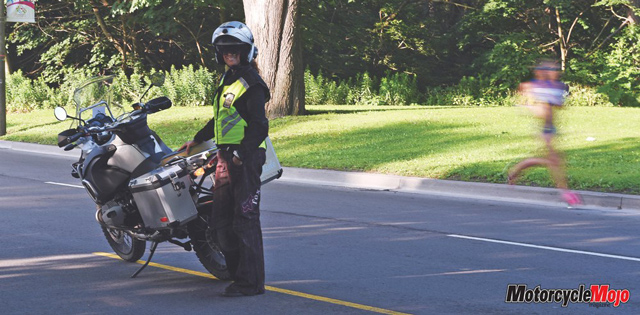Any day on a motorcycle is good, even when you’re outside your comfort zone
The summer of 2015 was truly a phenomenal one, as the Pan Am and Parapan Am Games came to Toronto. Maybe, like many people, I didn’t really pay too much attention when the Games were awarded to Toronto in 2009. And maybe, like many people, I also was not aware that the Pan American Games are the world’s third-largest international multi-sport event held every four years, surpassed in size only by the Olympic Summer Games and the Asian Games. It was also pretty impressive to find out that close to 7,000 athletes from across Latin America, South America, the Caribbean and North America were coming together to compete in 36 Pan Am and 15 Parapan Am sports. Interesting, but what does this have to do with motorcycling?
Motorcycle Support

A Variety of Tasks

Let the Games Begin

During the marathon competition, I hosted a photojournalist from Chile named Hector. He was fantastic to work with and again provided another level to carrying a passenger, as his camera and lens was almost as big as he was. We quickly developed a routine throughout the two days we spent together, and I have some fantastic photos as evidence.
Tricky Riding
And then (cue music) – there was the road cycling event. Nothing, absolutely nothing, prepared me for being part of a caravan of at least 35 vehicles travelling behind a large pack of cyclists (the peloton) topping ridiculous speeds along our city streets. If you are at all familiar with Toronto’s High Park, let’s talk about Ellis Park Road and, in particular, Olympus Avenue. They turned this into an upward hairpin on the course: a narrow residential street lined on both sides by the crowds who came out to support the athletes.
Now, on its own, and me piloting my own motorcycle, would have been no problem. But I was carrying Ann, a commissaire, and we were to stick with her official’s car to pass notes back and forth. I kid you not. I had to negotiate this upward hairpin, going at approximately less than 3 km/h while attempting to pick my line, with bicycles, cars, motorcycles, other support vehicles and people with cameras. It was 10 times around the course for the men and six times for the women. This section was easily the most challenging and heart-pumping experience of the Games on a motorcycle.
Parapan Am Games
A completely inspirational day came on August 8, with the para-cycling road race. Athletes with physical impairments competed on handcycles, tricycles or bicycles. Those with visual impairments competed on tandems with a sighted “pilot.” For the road race, I was the lead for the handcyclists. With their low profile, these athletes really sneak up on you, and I not only had to keep my eye out low and to the sides, but on my speed as well. I was privileged to be able to witness firsthand Canada’s Mark Ledo receive gold in his classification. Canada also took the bronze. Not to minimize the Pan Am athletes, but what these athletes could do with limited arm function, complete loss of trunk and leg function, amputations and other activity limitations was truly inspiring. They most definitely defined the phrase “anything is possible.”
To be quite truthful, I may have been part of the masses who considered the Pan Am Games the instigator of all nightmare traffic conditions for the better part of summer 2015. The traffic congestion and costs provided plenty for everyone to complain about.
Certainly, I wouldn’t have gone down to watch any of the events live. But instead, I got to ride my bike down the HOV lanes; ride closed city streets along Toronto’s waterfront; meet athletes, officials and volunteers; work with amazing people; and be part of the Games – it was absolutely spectacular. There were really early mornings and late evenings, but I would not have changed the experience for the world.
Yep. Undoubtedly, the best seat in the house.
















